snow chains AUDI A5 2015 Owner´s Manual
[x] Cancel search | Manufacturer: AUDI, Model Year: 2015, Model line: A5, Model: AUDI A5 2015Pages: 264, PDF Size: 66.83 MB
Page 110 of 264
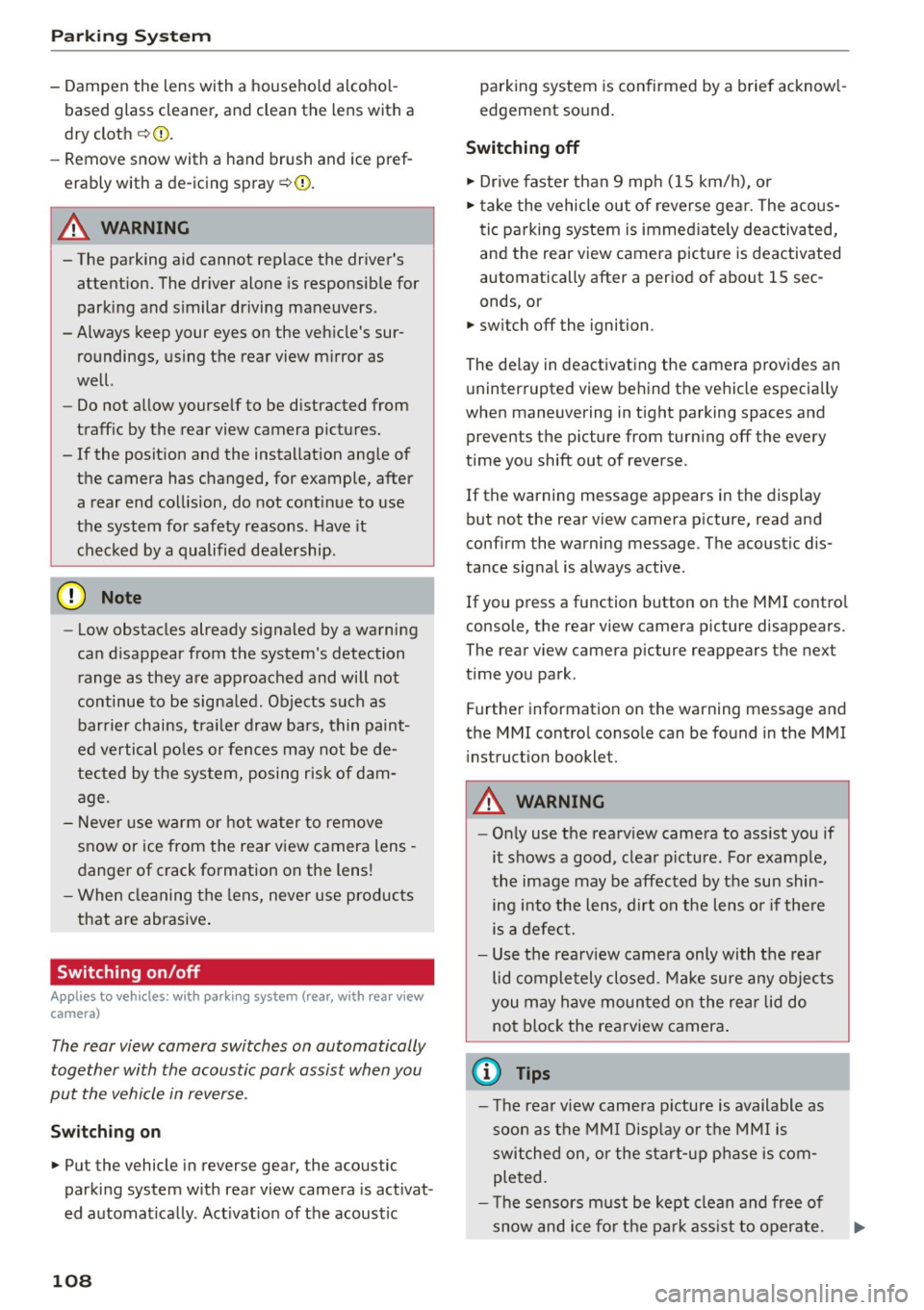
Parkin g Sys tem
-Dampen the lens with a househo ld alcoho l
based glass cleaner, and clean the lens with a
dry cloth
c:::> 0 .
- Remove snow with a hand brush and ice pref
erably with a de -icing spray
c:::> 0 .
A WARNING
- The parking aid cannot replace the driver's
attention. The dr iver alone is responsib le for
parking and s imilar driving maneuvers.
- Always keep your eyes on the veh icle's sur
roundings, us ing the rear view m irror as
well.
- Do not a llow yourself to be distracted from
traff ic by the rear view camera pictures.
- If the posit ion and the installation ang le of
the camera has changed, for example, after
a rear end collision, do not continue to use
the system for safety reasons. Have it
checked by a qualified dealership.
(D Note
- Low obstacles already signaled by a warning
can d isappear from the system's detection
range as they are approached and will not
continue to be signa led. Objects such as
barrier chains, tra iler draw bars, thin paint
ed vertical po les or fences may not be de
tected by the sys tem, posing risk of dam
age.
- Never use warm or hot water to remove
snow or ice from the rear view camera lens -
danger of crack formation on the lens!
- When cleaning the lens, never use products
that are abrasive .
Switching on/off
A ppl ies to ve hicles: w ith pa rking system (rea r, w ith rea r view
c am era)
The rear view camera switches on automatically
together with the acoustic park assist when you
put the vehicle in reverse.
S w itch ing on
"' Put the vehicle in reverse gear, the acoustic
parking system w ith rear view camera is act ivat
ed automat ically. Act ivat ion of the acoustic
108
parking system is confirmed by a brief acknow l
edgement sound.
Switching off
"' Dr ive faste r than 9 mph ( 15 km/h), or
"' take the vehicle out of reverse gear. The acous
tic parking system is immed iate ly deactivated,
and the rear view camera picture is deactivated
automatically after a period of about 15 sec
onds, or
"' sw itch
off the ignition.
The delay in deactivating the camera provides an uninterrupted view behind the vehicle especia lly
when maneuvering in t ight parking spaces and
prevents the picture from turn ing
off the every
time you shift out of reverse .
If the warning message appears in the display
but not the rear v iew camera p icture, read and
confirm the warning message. The acoustic dis
tance signal is always active.
If you press a function button on the MMI contro l
console, the rear view camera p icture disappears.
The rear v iew camera picture reappears the next
time you park.
Further information on the warning message and
the MMI contro l conso le can be found in the MMI
instruct ion booklet.
A WARNING
- On ly use the rearv iew camera to assist you if
it shows a good, clea r picture. For example,
the image may be affected by the sun shin
ing into the lens, dirt on the lens o r if there
is a de fec t.
- Use the rea rv iew camera only with the rear
lid completely closed. Make sure any objects
you may have moun ted o n the rear lid do
no t block the rearv iew camera .
@ Tips
-The rear view came ra p icture is available as
soon as the MMI Disp lay o r th e MMI is
switched on, or the start-up phase is com
pleted.
- The sensors m ust be kept clean and free of
snow and ice for the park ass ist to operate.
Page 174 of 264

Smart Technology
The following situations are exceptions where it
may be usefu l to switch on sport mode to allow
the wheels to spin : -
Rocking the vehicle to free it when it is stuck
- Driv ing in deep snow or on loose ground
- Dr iv ing with snow chains
Sport mode on ESC/ASR off Sport mode off or
ESC /ASRon
Behavior
The ESC and ASR stabiliza- The stabilization funct ion is The full stabilization func-
tion fu nct ions are limited not
available¢ ,&.. ESC and
tion of the ESC and ASR is
¢ ,&. .
ASR are switched
off. available again.
Operation Press the I!> OF F! button Press and hold the I!> OF FI Press the I!> OF F! button
briefly . button longer than 3 sec-again.
onds .
Indicator II turns on. JI and lf'lii•li~ turn on. II turns off or II and
lights lf'lii•l~~ turn off.
Driver mes- Stabilization control (ESC): Stabilization control (ESC): Stabilization control
sages Sport. Warning! Re stricted off. Warning! Restricted (ESC):
On
stability stability
It is only possible to turn off the ASR up to 30
mph (SO km/h) for veh icles wi th front whee l
drive . At about
45 mph (70 km/h) it automatica l
ly turns on again. It is possible to turn
off the
ASR at any speed for vehicles with all whee l
drive.
A WARNING
-
You should only sw itch sport mode on or
switch ESC/ASR
off if your driving ab ilities and
road condit io ns perm it .
- The stabilization function is limited when
sport mode is switched on. The dr iv ing
wheels could spin and the veh icle cou ld
swerve, especially on slick or slippery road
surfaces.
- There is no vehicle stabilization when ESC/
ASR are switched
off.
(D Tips
ESC/ASR cannot be switched off or sport
mode cannot be switched on when cruise con
trol or adaptive cru ise control* is sw itched on .
172
Braking
What affects broking efficiency?
New brake pads
During the first 250 miles (400 km), new brake
pads do not possess their full braking effect, they
have to be "broken in" first¢,&. . You can com
pensate for this slightly reduced braking power
by pushing harder on the brake pedal. Avoid
heavy braking loads during the break-in period.
Operating conditions and driving habits
The brakes on today's automobiles are still sub
ject to wear, depending largely on operating con
ditions and driving habits~,&. . On vehicles that
are either driven most ly in stop-and -go city traf
fic or are driven hard, the brake pads should be
checked by your authorized Audi dealer more of
ten than specified in the
Warranty & Mainte
nance booklet .
Failure to have your brake pads
i nspected can result in reduced brake perform
ance .
On steep slopes, you should use the braking ef
fect of the engine . This way, you prevent unnec
essary wear on the brake system. If you must use
your brakes, do not hold the brakes down contin
uously. Pump the brakes at intervals.
Page 177 of 264
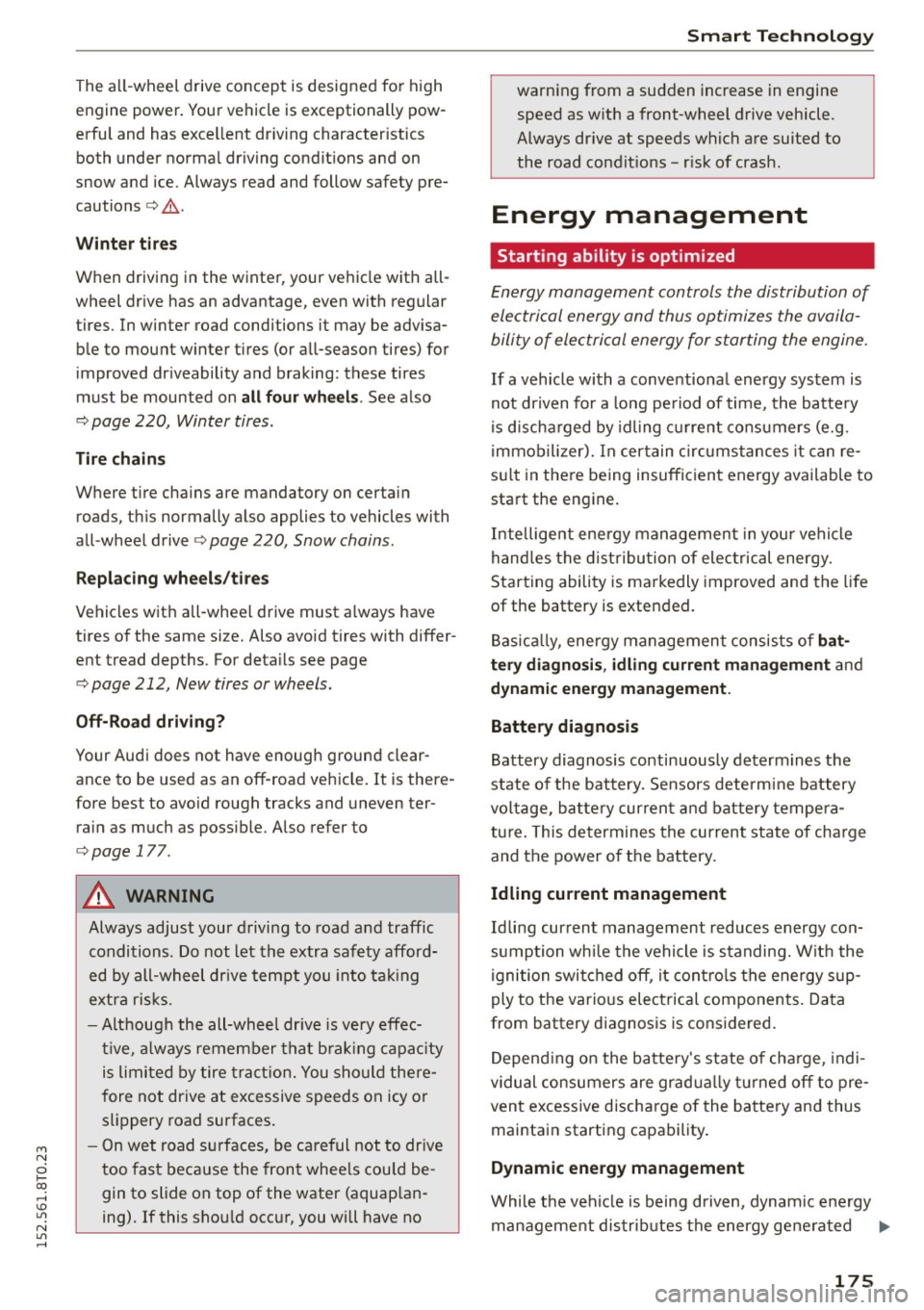
M N
i? co ,...., \!) ..,.,
N ..,., ,....,
The all-wheel drive concept is designed for high
engine power . Your vehicle is exceptionally pow
erful and has excellent driving character istics
both under normal driving conditions and on
snow and ice. Always read and follow safety pre
cautions <=>
,&.
Winter tire s
When driving in the winter, your vehicle with all
wheel drive has an advantage, even with regular
tires. In winter road conditions it may be advisa
ble to mount w inter tires (or all-season tires) for
improved driveability and braking: these tires
must be mounted on
all four wheels. See also
<=> page 220, Winter tires.
Tire chains
Where tire chains are mandatory on certain
roads, this normally also applies to vehicles with
all-wheel drive <=>
page 220, Snow chains.
Replacing wheels/tires
Vehicles with all-wheel drive must a lways have
tires of the same size. Also avoid tires with differ
ent tread depths. For details see page
<=>
page 212, New tires or wheels.
Off-Road driving?
Your Audi does not have enough ground clear
ance to be used as an off-road vehicle. It is there
fore best to avoid rough tracks and uneven ter
rain as much as possible. Also refer to
<=>page 177.
A WARNING
Always adjust your driving to road and traffic
conditions. Do not let the extra safety afford
ed by all-wheel drive tempt you into taking
extra risks.
- Although the all-wheel dr ive is very effec
t ive, always remember that braking capacity
is limited by tire traction. You should there
fore not drive at excessive speeds on icy or
slippery road surfaces.
- On wet road surfaces, be careful not to dr ive
too fast because the front wheels could be
gin to slide on top of the water (aquap lan
ing). If this shou ld occur, you will have no
Smart Technology
warning from a sudden increase in engine
speed as with a front-wheel drive vehicle.
Always drive at speeds which are suited to the road conditions -risk of crash.
Energy management
Starting ability is optimized
Energy management controls the distribution of
electrical energy and thus optimizes the availa
bility of electrical energy for starting the engine.
If a vehicle with a conventional energy system is
not driven for a long pe riod of time, the battery
is discharged by idling current consumers (e.g.
i mmobil izer). In certain circumstances it can re
su lt in there being insufficient energy available to
start the engine.
Intelligent energy management in your vehicle
hand les the distribution of electrical energy.
Starting ability is markedly improved and the life
of the battery is extended.
Basically, energy management consists of
bat
tery diagnosis , idling current management
and
dynamic energy management.
Battery diagnosis
Battery diagnosis continuously determines the
state of the battery . Sensors determine battery
vo lta ge, battery current and battery tempera
tu re. This determines the current state of charge
and the power of the battery.
Idling current management
Idling current management reduces energy con
sumption whi le the vehicle is standing. With the
ignition switched off, it contro ls the energy sup
ply to the various electrical components. Data
from battery diagnosis is considered.
Depending on the battery's state of charge, indi
vidual consumers are gradually turned off to pre
vent excessive discharge of the battery and thus
maintain starting capability .
Dynamic energy management
While the vehicle is being driven, dynamic energy
management distr ibutes the energy generated ..,.
175
Page 222 of 264
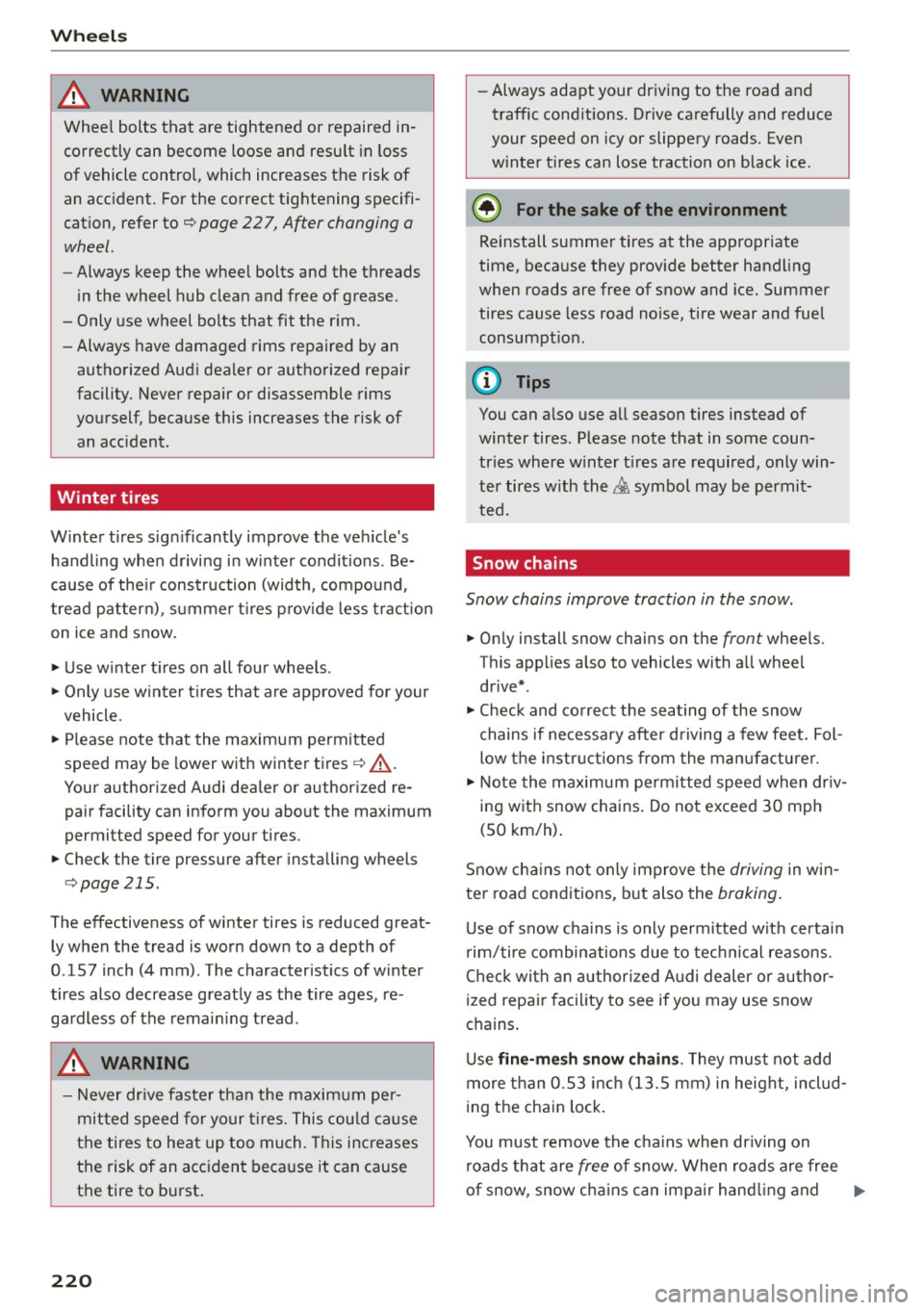
Wheels
A WARNING
Wheel bolts that are tightened or repaired incorrectly can become loose and result in loss
of vehicle control , which increases the risk of
an accident. For the correct tightening specifi
cation, refer to
c:> page 22 7, After changing a
wheel.
- Always keep the wheel bolts and the threads
in the wheel hub clean and free of grease.
- Only use wheel bolts that fit the rim .
- Always have damaged rims repaired by an
authorized Audi dealer or authorized repair
facility. Never repair or disassemble rims
yourself, because this increases the risk of an accident.
Winter tires
Winter tires significantly improve the vehicle's handling when driving in winter conditions . Be
cause of their construction (width, compound,
tread pattern), summer tires provide less traction
on ice and snow.
.., Use winter tires on all four wheels .
.., Only use winter tires that are approved for your
vehicle.
.., Please note that the maximum permitted
speed may be lower with winter tires
c:> .&,.
Your authorized Audi dealer or authorized re
pai r facility can inform you about the maximum
permitted speed for your tires .
.., Check the tire pressure after installing wheels
c:> page 215.
The effectiveness of winter tires is reduced great
ly when the tread is worn down to a depth of
0 .1S7 inch (4 mm). The characteristics of winter
tires also decrease greatly as the tire ages, re
gardless of the remaining tread.
A WARNING
-Never drive faster than the maximum per
mitted speed for your t ires. This could cause
the tires to heat up too much . This increases
the risk of an accident because it can cause
the tire to burst.
220
- Always adapt your driving to the road and
traffic conditions. Drive carefully and reduce
your speed on icy or slippery roads. Even
winter tires can lose traction on black ice.
@ For the sake of the environment
Reinstall summer tires at the appropriate
time, because they provide better handling
when roads are free of snow and ice. Summer
tires cause less road noise, tire wear and fuel
consumpt ion.
(D Tips
You can also use all season tires instead of
winter tires. Please note that in some coun
tries where winter tires are required, only win
ter tires w ith the
& symbol may be permit
ted.
· Snow chains
Snow chains improve traction in the snow .
.., Only install snow chains on the front wheels.
This applies also to vehicles with all wheel drive* .
.., Check and correct the seating of the snow
chains if necessary after driving a few feet. Fol
low the instructions from the manufacturer .
.., Note the maximum permitted speed when driv
ing with snow chains . Do not exceed 30 mph
(SO km/h) .
Snow chains not only improve the
driving in win
ter road conditions, but also the
braking.
Use of snow chains is only permitted with certain
rim/tire combinations due to technical reasons.
Check with an authorized Audi dealer or author
ized repair facility to see if you may use snow
chains .
Use
fine-mesh snow chains. They must not add
more than 0.53 inch (13.S mm) in height, includ
ing the chain lock.
You must remove the chains when driving on
roads that are
free of snow. When roads are free
of snow, snow chains can impair handling and .,.
Page 223 of 264
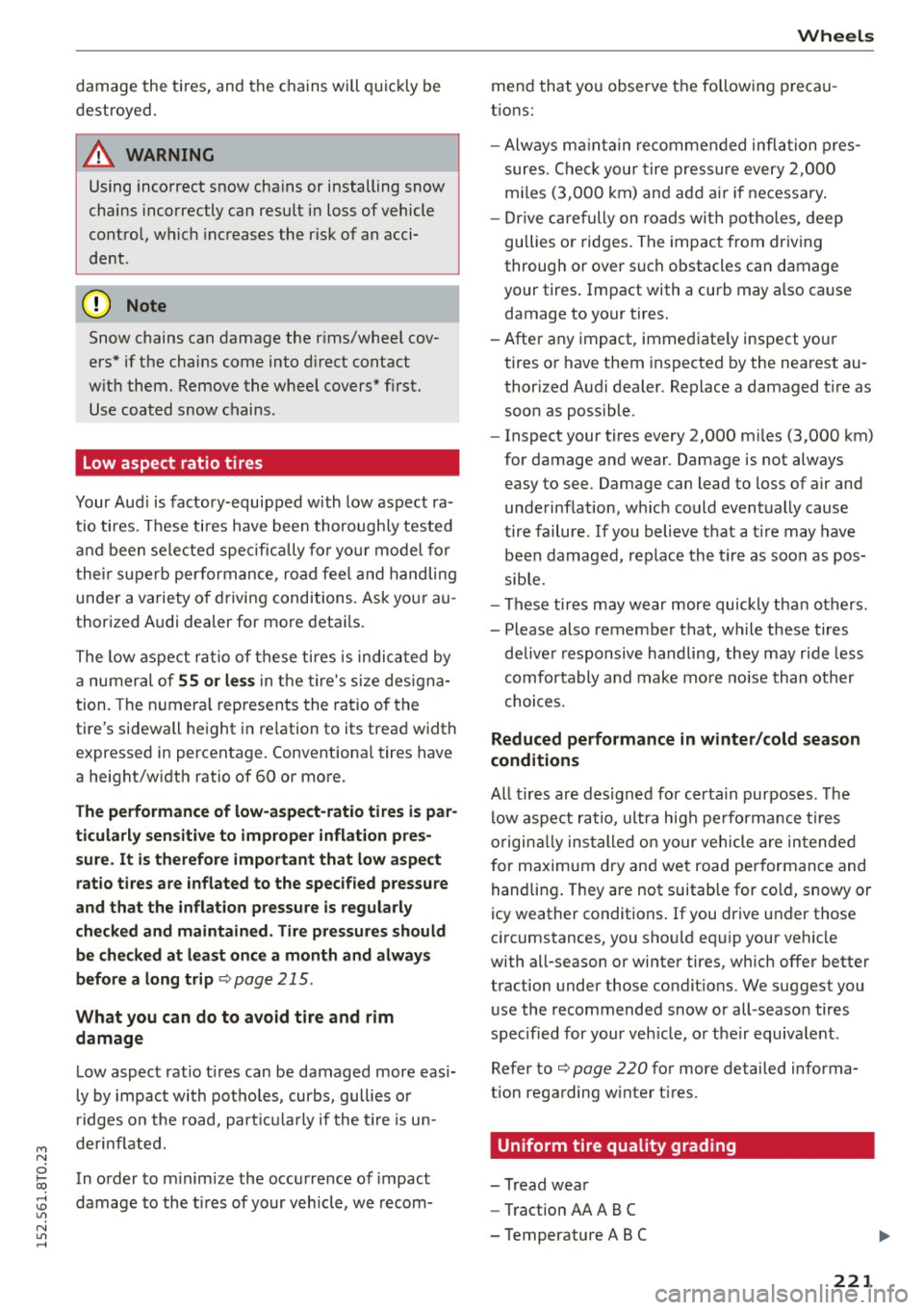
M N
i? co ,...., \!) ..,.,
N ..,., ,....,
damage the t ires, and the c hains will quickly be
destroye d.
A WARNING
Using inco rrect snow cha ins or installing snow
chains incorrectly can resu lt i n loss of vehicle
cont ro l, whic h increases the r isk of an acci
de nt.
(D Note
Snow chains can dama ge the r ims/whee l cov
ers * if th e cha ins come into d irect contact
w it h them. Remove the whee l cov ers* f irst .
Use coat ed snow c hains.
Low aspect ratio tires
Your Au di is factory -equip ped wi th low as pect ra
tio ti res. T hese ti res have bee n thoroughly teste d
a nd been se le cted specific ally fo r your model fo r
t he ir su perb pe rformance, road feel and handling
u nd er a variety o f driving conditions . Ask yo ur au
thor ized A udi dealer for mo re deta ils.
The low aspe ct r atio of these ti res i s indic ated by
a numer al of
55 or les s in th e tire's si ze des igna
tion. The nu mera l represen ts the ra ti o of the
tire's sidewall he ight in relation to its trea d width
e x pressed in percentage. Convent io na l tires have
a he ight/w idth ratio of 60 or mo re.
The performance of low-aspect-ratio tires is par
ticularly sensitive to improper inflation pres
sure . It is therefore important that low aspect
ratio tires are inflated to the specified pressure
and that the inflation pressure is regularly
checked and maintained . Tire pressures should
be checked at least once a month and always
before a long trip
¢ pag e 215.
What you can do to avoid tire and rim
damage
L ow aspec t rat io t ires ca n be damaged more easi
l y by impact wi th pot ho les, curbs, gulli es or
r idges on the road, par ticularly if the tire is un
de rin fla ted.
In o rder to m inim ize the occu rrence o f impact
damage to the t ires of your v ehicl e, we recom-
Wheels
me nd that yo u observe the follow ing p recau
t ions:
- Alw ays m aintain r eco m me nded infl ation pre s
sures. C heck your tire pressure every 2,000
m iles (3,00 0 km) an d ad d air if necessary .
- Dr ive c arefully on road s wi th pot holes, deep
gu llies o r ridges. The impac t from dr iv ing
through or over s uch obstacles can damage
your tires . Impact with a curb may a lso ca use
damage to your tires .
- After a ny impact, imme diate ly inspect yo ur
tires o r have them inspected by the nearest au
thorized A udi dealer. Rep lace a damaged t ire as
soon as possible.
- Inspect your tires every 2,000 m iles (3,000 km)
for damage and wear . Damage is not always
easy to see. Damage can lead to loss of air and
unde rinflation, w hich could even tually cause
t ire failure .
If you beli eve that a t ire may have
been damaged, re place the t ire as soon as pos
s ible.
- These ti res may wear more quickly tha n oth ers .
- Please also remember that, wh ile these tires
delive r responsiv e han dling, they may r ide less
comfortably and make mo re no ise than other
c h o ic e s.
Reduced performance in winter/cold season
conditions
All t ir e s ar e designed for certa in purpos es. T he
l ow asp ect ra tio, ultr a hig h perfor man ce tire s
o rigi nall y insta lled on y our veh icle are in tende d
f or m aximum dry an d we t road pe rformance and
handli ng. They are not suitab le for co ld , snowy or
icy weather conditions . If you dr ive under those
c ircumstances , you sho uld eq uip your vehicle
with all-season or winter tires, which offer better
t raction unde r those co ndit io ns. We suggest you
u se the recommended snow or all-seaso n tires
spec ified for your veh icle, o r the ir equiva le nt.
Refer to¢
page 220 for more detailed informa
t ion regarding w inte r tir es.
Uniform tire quality grading
- Tread wea r
- Traction AA AB C
- Temperature AB C
221
Page 226 of 264
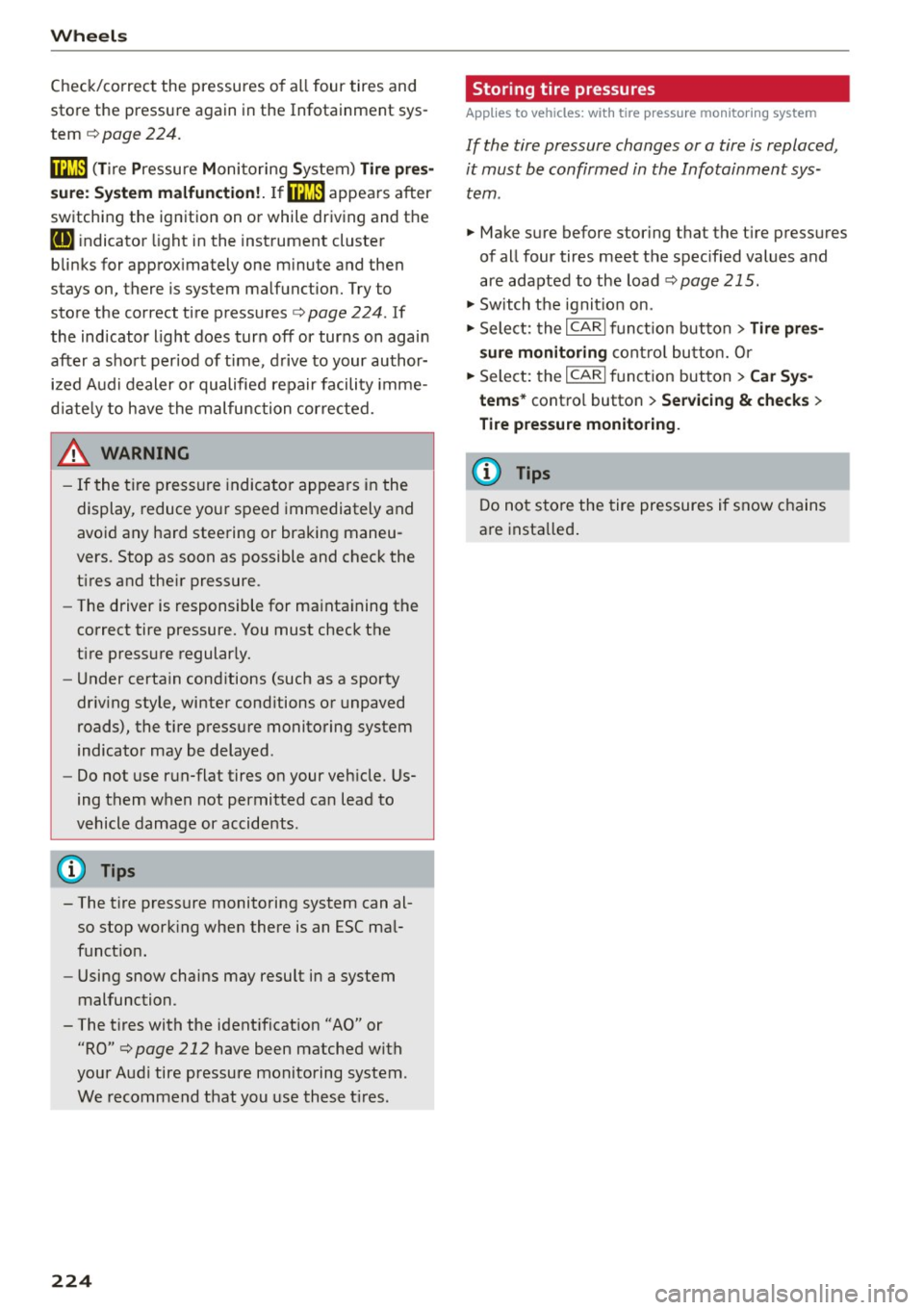
Wheels
Check/correct the pressures of all four tires and
store the pressure again in the Infotainment sys
tem
c!) page 224.
mm (Tire Pressure Monitoring System) Tire pres
sure: System malfunction!.
If m appears after
switching the ignition on or while driving and the
[I] i ndicator light in the instrument cluster
blinks for approximately one minute and then
stays on, there is system malfunction. Try to
store the correct tire pressures
c:> page 224 . If
the indicator light does turn off or turns on again
after a short period of time, drive to your author
ized Audi dealer or qualified repair facility imme
diately to have the malfunction corrected.
A WARNING
-If the tire pressure indicator appears in the
display, reduce your speed immediately and
avoid any hard steering or braking maneu
vers. Stop as soon as possible and check the
tires and their pressure.
- The driver is responsible for maintaining the
correct tire pressure. You must check the
tire pressure regularly.
-Under certain conditions (such as a sporty
driving style, winter conditions or unpaved
roads), the tire pressure monitoring system
indicator may be delayed.
- Do not use run-flat tires on your vehicle. Us
ing them when not permitted can lead to
vehicle damage or accidents.
(D Tips
- The tire pressure monitoring system can al
so stop working when there is an ESC mal
function.
- Using snow chains may result in a system
malfunction.
- The tires with the identification "AO" or
"RO"
c:> page 212 have been matched with
your Audi tire pressure monitoring system.
We recommend that you use these tires.
224
· Storing tire pressures
App lies to vehicles: wit h tire press ure mo nitor ing system
If the tire pressure changes or a tire is replaced,
it must be confirmed in the Infotainment sys
tem .
.,. Make sure before storing that the tire pressures
of all four tires meet the spec ified values and
are adapted to the load
c!) page 215.
.,. Switch the ignition on.
.,. Select: the
I CARI function button > Tire pres
sure monitoring
control button. Or
.,. Select: the
I CARI function button > Car Sys
tems*
control button > Servicing & checks >
Tire pressure monitoring.
(D Tips
Do not store the tire pressures if snow chains
a re i nsta lied.
Page 228 of 264
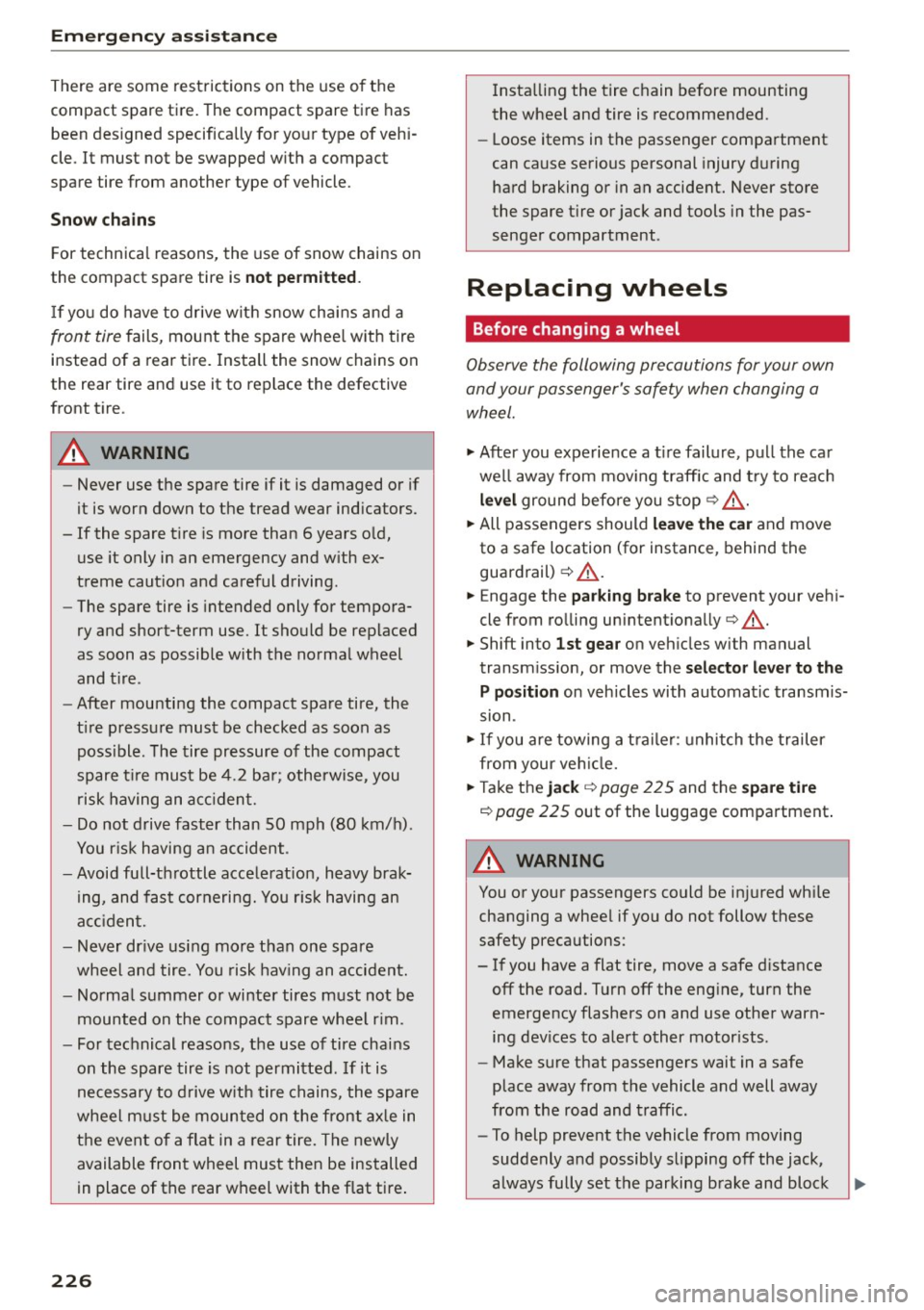
Emerg enc y ass is tance
There are some restrictions on the use of the
compact spare tire. The compact spare tire has
been designed specifically for your type of vehi
cle. It must not be swapped w ith a compact
spare tire from another type of vehicle.
Snow chain s
For technical reasons, the use of snow chains on
the compact spare tire is
n ot permitted .
If you do have to drive w ith snow cha ins and a
front tire f ails, mount the spare whee l with tire
instead of a rear tire. Install the snow chains on
the rear tire and use it to replace the defective
front tire .
A WARNING
-Never use the spare tire if it is damaged or if
it is worn down to the tread wear ind icators.
- If the spare t ire is more than 6 years o ld,
use it only in an emergency and w ith ex
treme caut ion and careful driving.
- The spare tire is intended only for tempora
ry and short-term use.
It should be replaced
as soon as possible with the norma l wheel
and t ire.
- After mounti ng the compact spare tire, the
t ire pressure must be checked as soon as
poss ible. The tire pressure of the compact
spare t ire must be 4.2 bar; otherwise, you
risk having an a cc ident.
- Do not drive faster than 50 mph (80 km/h) .
You r isk having an accident.
- Avoid full-throttle acce lerat ion, heavy brak
ing, and fast corneri ng. You r is k having an
a cc ident.
- Never dr ive using more than one spare
wheel and tire. You risk hav ing an accident.
- Norma l summer or winter tires must not be
mounted on the compact spare whee l rim.
- For technical reasons, the use of tire chains
on the spare tire is not permitted. If it is
necessary to drive w ith tire chains, the spare
wheel m ust be mounted on the front axle in
the event of a flat in a rear tire. The new ly
available front wheel must then be installed
in place of the rear wheel with the flat tire .
226
Installing the tire chain before mounting
the wheel and tire is recommended.
- Loose items in the passenger compartment
can cause serious personal injury during
hard braking or in an accident. Never store
the spare t ire or jack and tools in the pas
senger compartment .
Replacing wheels
Before changing a wheel
Observe the following precautions for your own
and your passenger 's safety when changing a
wheel.
~ After you experience a t ire failure, pu ll the ca r
wel l away from mov ing traffic and t ry to reac h
le vel ground before you stop ¢ ,& .
~ All passengers should lea ve the car and move
to a safe location (for instance, behind the
guardrail) ¢,& .
~ Engage the pa rking brake to prevent your vehi
cle from ro lling unintent ionally¢ ,&.
~ Shift into 1st gear on veh icles with manual
transm iss ion, or move the
selector lev er to the
P po sition
on vehicles with automatic transmis
sion .
~ If you are towing a trai le r: unhit ch the trailer
from your ve hicle.
~ Take the jack ¢ page 225 and the spare tire
¢ page 225 out of the luggage compartment .
A WARNING
You or your passengers could be injured wh ile
changing a whee l if you do not follow these
safety precautions:
- If you have a flat tire, move a safe d ista nee
off the road. Turn off the eng ine, turn the
emergency flashers on and use other warn ing dev ices to alert other motor ists.
- Make sure that passengers wait in a safe
place away from the vehicle and well away
from the road and traffic.
- To help preve nt the vehicle from moving
suddenly and possibly slipping off the jack,
always fully set the parking b rake and block
liJ,,
Page 259 of 264
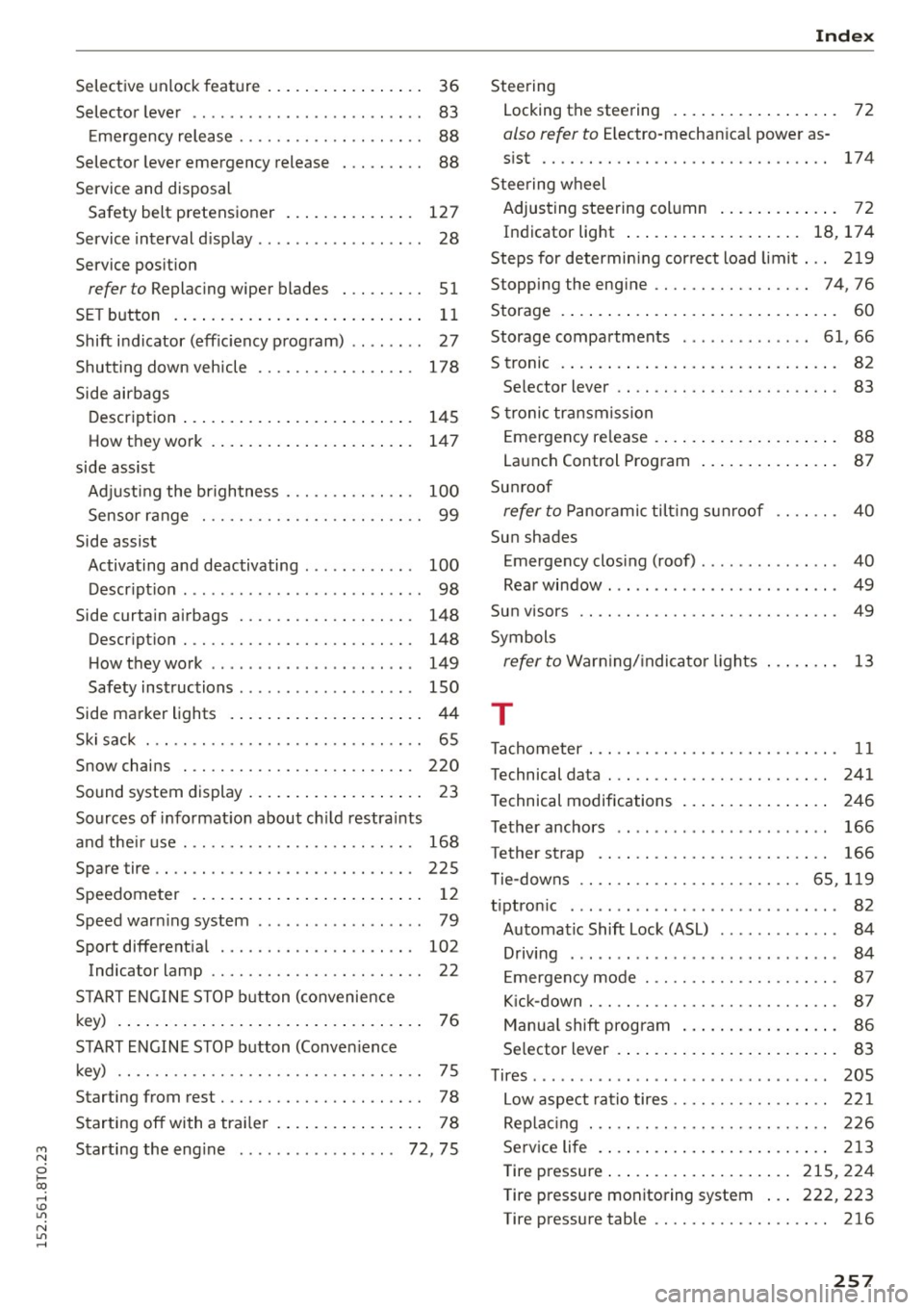
Selective unlock feature . . . . . . . . . . . . . . . . . 36
Selector lever . . . . . . . . . . . . . . . . . . . . . . . . . 83
E mergency release . . . . . . . . . . . . . . . . . . . . 88
Selector lever emergency release . . . . . . . . . 88
Service and disposal Safety belt pretensioner . . . . . . . . . . . . . . 127
Service interval display . . . . . . . . . . . . . . . . . . 28
Service position
refer to Replacing wiper blades . . . . . . . . . 51
SE T button . . . . . . . . . . . . . . . . . . . . . . . . . . . 11
Shift indicator (efficiency program) . . . . . . . . 27
Shutting down vehicle . . . . . . . . . . . . . . . . . 178
Side airbags
Description . . . . . . . . . . . . . . . . . . . . . . . . . 145
How they work . . . . . . . . . . . . . . . . . . . . . . 147
side assist Adjusting the brightness . . . . . . . . . . . . . . 100
Sensor range . . . . . . . . . . . . . . . . . . . . . . . . 99
Side assist Activating and deactivating . . . . . . . . . . . . 100
Description . . . . . . . . . . . . . . . . . . . . . . . . . . 98
Side curtain airbags . . . . . . . . . . . . . . . . . . . 148
Description . . . . . . . . . . . . . . . . . . . . . . . . . 148
How they work . . . . . . . . . . . . . . . . . . . . . . 149
Safety instructions . . . . . . . . . . . . . . . . . . . 150
Side marker lights . . . . . . . . . . . . . . . . . . . . .
44
Ski sack . . . . . . . . . . . . . . . . . . . . . . . . . . . . . . 65
Snow chains . . . . . . . . . . . . . . . . . . . . . . . . . 220
Sound system display . . . . . . . . . . . . . . . . . . . 23
Sources of information about child restraints
and the ir use . . . . . . . . . . . . . . . . . . . . . . . . . 168
Spare tire . . . . . . . . . . . . . . . . . . . . . . . . . . . . 225
Speedometer . . . . . . . . . . . . . . . . . . . . . . . . . 12
Speed warn ing system . . . . . . . . . . . . . . . . . . 79
Sport differential . . . . . . . . . . . . . . . . . . . . . 102
Indicator lamp . . . . . . . . . . . . . . . . . . . . . . . 22
START ENGINE STOP button (convenience
key) . . . . . . . . . . . . . . . . . . . . . . . . . . . . . . . . . 76
START ENGINE STOP button (Convenience key) . . . . . . . . . . . . . . . . . . . . . . . . . . . . . . . . . 75
Starting from rest . . . . . . . . . . . . . . . . . . . . . . 78
Starting off with a trai ler . . . . . . . . . . . . . . . . 78
~ Start ing the engine . . . . . . . . . . . . . . . . . 72, 75
i? co ,...., \!) 1.1'1
N 1.1'1 ,....,
Index
Steering
Locking the steering . . . . . . . . . . . . . . . . . . 72
also refer to Electro-mechan ical power as-
sist .. .... .... .. ............. .... .. 174
Steering wheel Adjusting steering column . . . . . . . . . . . . . 72
Indicator light ... ................ 18, 174
Steps for determin ing correct load limit . . . 219
Stopping the engine . . . . . . . . . . . . . . . . . 74, 76
Storage . . . . . . . . . . . . . . . . . . . . . . . . . . . . . . 60
Storage compartments . . . . . . . . . . . . . . 61, 66
S tronic . . . . . . . . . . . . . . . . . . . . . . . . . . . . . . 82
Selector lever . . . . . . . . . . . . . . . . . . . . . . . . 83
S tronic transmission
Emergency release . . . . . . . . . . . . . . . . . . . . 88
Launch Control Program . . . . . . . . . . . . . . . 87
Sunroof
refer to Panoramic tilting sunroof . . . . . . . 40
Sun shades
Emergency closing (roof) . . . . . . . . . . . . . . .
40
Rear window . . . . . . . . . . . . . . . . . . . . . . . . . 49
Sun visors . . . . . . . . . . . . . . . . . . . . . . . . . . . . 49
Symbols
refer to Warning/indicator lights . . . . . . . . 13
T
Tachometer . . . . . . . . . . . . . . . . . . . . . . . . . . . 11
Technical data . . . . . . . . . . . . . . . . . . . . . . . . 241
T echnical modifications . . . . . . . . . . . . . . . . 246
Tether anchors . . . . . . . . . . . . . . . . . . . . . . . 166
Tether strap . . . . . . . . . . . . . . . . . . . . . . . . . 166
Tie-downs ...... .. ............. ... 65, 119
tiptronic . . . . . . . . . . . . . . . . . . . . . . . . . . . . . 82
Automatic Shift Lock (ASL) . . . . . . . . . . . . . 84
Driving . . . . . . . . . . . . . . . . . . . . . . . . . . . . . 84
Emergency mode . . . . . . . . . . . . . . . . . . . . . 87
Kick-down . . . . . . . . . . . . . . . . . . . . . . . . . . . 87
Manual shift program . . . . . . . . . . . . . . . . . 86
Selector lever . . . . . . . . . . . . . . . . . . . . . . . . 83
Tires ........ ... .. .. ................. 205
Low aspect ratio tires . . . . . . . . . . . . . . . . . 221
Replac ing . . . . . . . . . . . . . . . . . . . . . . . . . . 226
Service life . ... .. .. .............. ... 213
Tire pressure . . . . . . . . . . . . . . . . . . . . 215, 224
Tire pressure monitoring system . . . 222, 223
Tire pressure table . . . . . . . . . . . . . . . . . . . 216
257
Page 261 of 264
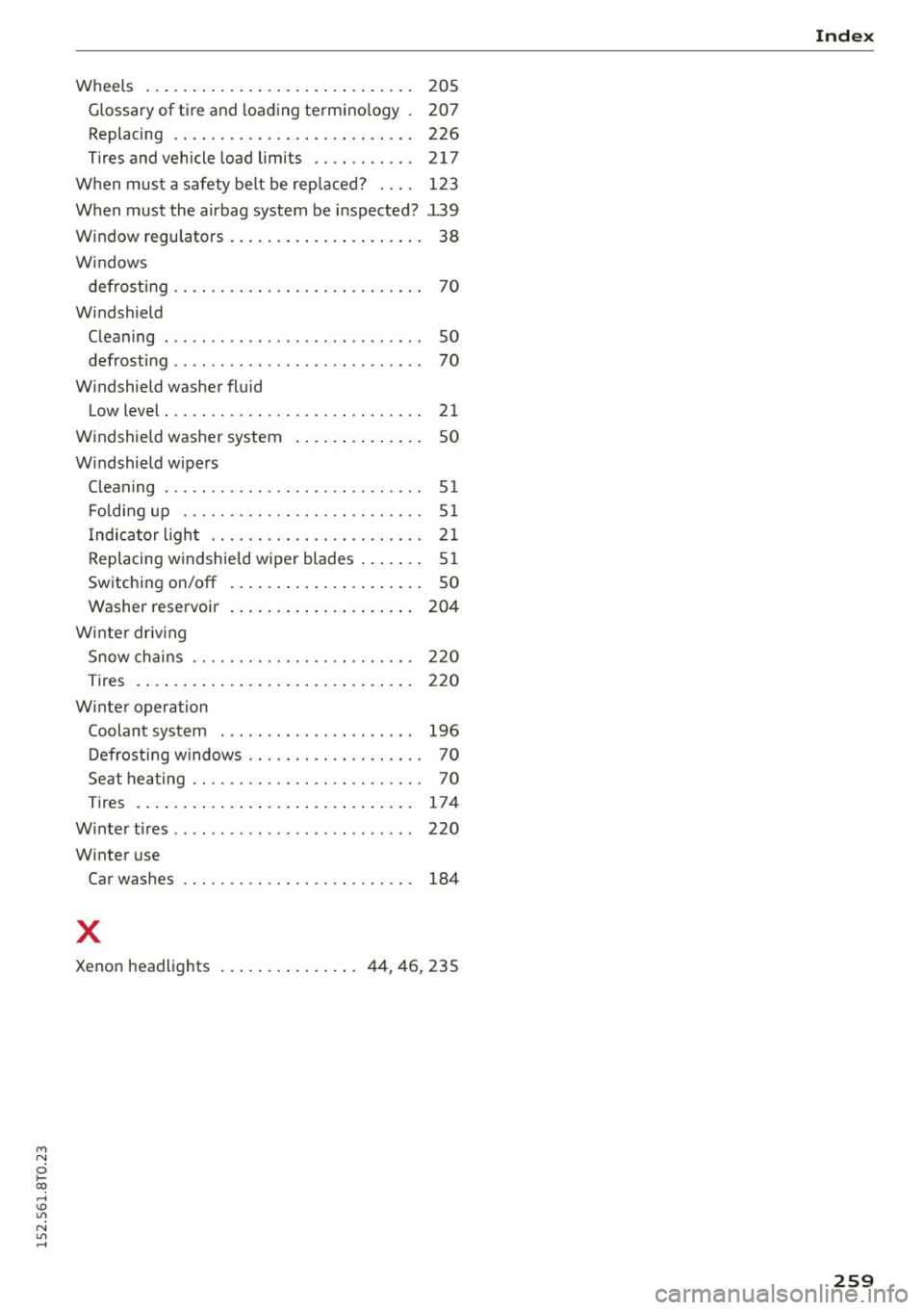
M N
i? co ,...., \!) ..,.,
N ..,., ,....,
Wheels ..... .. .............. ... .... . 205
Glossary of tire and loading termino logy . 207
Replacing . . . . . . . . . . . . . . . . . . . . . . . . . . 226
Tires and vehicle load limits .. .. .. .. ... 217
When must a safety belt be rep laced? . . . . 123
When must the airbag system be inspected? l39
Window regulators . . . . . . . . . . . . . . . . . . . . . 38
W indows
defrost ing . . . . . . . . . . . . . . . . . . . . . . . . . . .
70
Windshield
Cleaning . . . . . . . . . . . . . . . . . . . . . . . . . . . .
50
defrosting . . . . . . . . . . . . . . . . . . . . . . . . . . . 70
Windshield washer fluid
Low level . . . . . . . . . . . . . . . . . . . . . . . . . . . .
21
Windshield washer system . . . . . . . . . . . . . . 50
W indshield wipers
Cleaning . . . . . . . . . . . . . . . . . . . . . . . . . . . .
51
Folding up . . . . . . . . . . . . . . . . . . . . . . . . . . 51
Indicator light . . . . . . . . . . . . . . . . . . . . . . . 21
Replacing windshield wiper blades . . . . . . . 51
Switching on/off . . . . . . . . . . . . . . . . . . . . . 50
Washer reservoir
W inter driv ing 204
Snow chains . . . . . . . . . . . . . . . . . . . . . . . . 220
Tires . . . . . . . . . . . . . . . . . . . . . . . . . . . . . .
220
Winter operation
Coolant system . . . . . . . . . . . . . . . . . . . . .
196
Defrosting windows . . . . . . . . . . . . . . . . . . . 70
Seat heating . . . . . . . . . . . . . . . . . . . . . . . . . 70
Tires . . . . . . . . . . . . . . . . . . . . . . . . . . . . . . 174
Winter tires . . . . . . . . . . . . . . . . . . . . . . . . . . 220
Winter use
Car washes
184
X
Xenon headlights ............... 44, 46, 235
Index
259